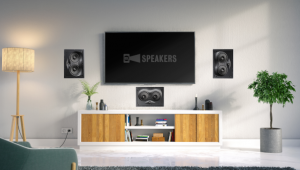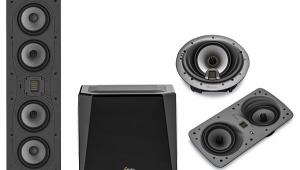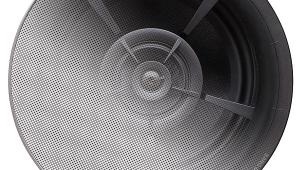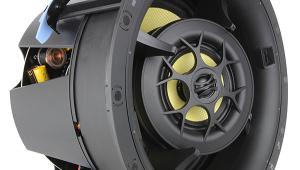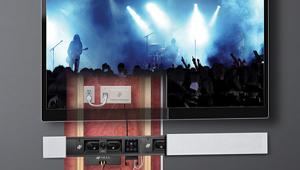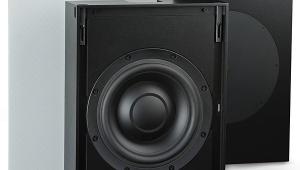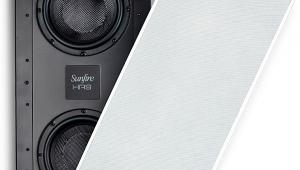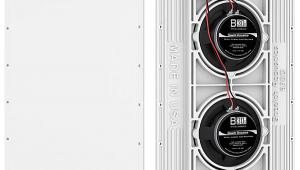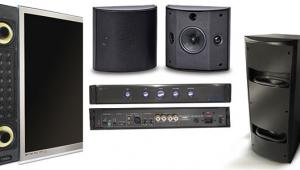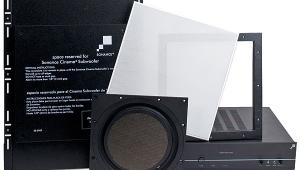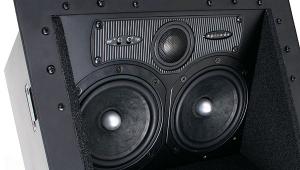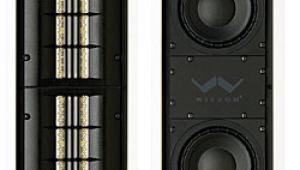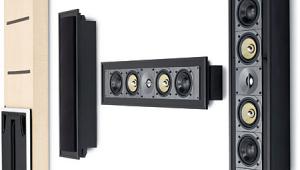Wisdom Audio Insight P4i In-Wall Speaker System
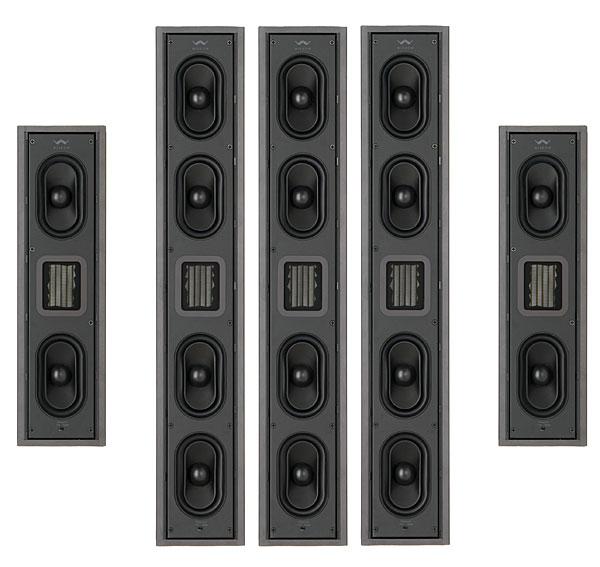
At a Glance
Plus
Planar magnetic thin-film drivers
Solid Uni-grip mounting clamps
Thin magnetically attached grilles available in custom lengths
Truly outstanding sound quality
Minus
Horizontal center channel use requires stud modifications
Definitely not the cheapest in-wall system you can buy
The Verdict
It might bust your budget on the front end, but the Wisdom Insight delivers a near-electrostatic, audiophile listening experience in a disappearing, in-wall package.
If you’re intimately familiar with Wisdom Audio, then you’re more dialed into this industry than I am. Sure, I’ve breezed by the company’s booth at past CEDIA Expos, but when I hear that name it always brings to mind the image of a of an old guy in a flowing robe with a long, white beard (and maybe a Harry Potter–esque wizard’s hat) sitting in an overstuffed chair in front of an audio system, his beard and hat being blown back à la the old Memorex advertising campaign.
One of the reasons Wisdom remained under my radar is that for many years after its founding in 1996, the company was completely focused—obsessed, even—with high-end, two-channel audio — specifically, freestanding speakers costing between $50,000 and $300,000 per pair. Beginning in 2006, however, Wisdom Audio began to reinvent itself, and developed a new, and relatively more affordable, series of in-wall speakers they decided to call Sage—clearly a clever association with the company’s name rather than any culinary skills possessed by the Wisdom team.
Wisdom Audio’s VP of sales, Jon Herron, told me that the design team believed (and still does) that architectural (i.e., in-wall) configurations and high-end performance were not mutually exclusive; and, as noted above, the Sage Series began with architectural versions before the company added on-wall and freestanding versions of the same models. But these aren’t your average in-wall designs. Along with using planar magnetic drivers (PMD) (which I’ll get to in a moment), Sage Series speakers require biamplification plus Wisdom Audio’s SC-1 System Controller, which incorporates an active crossover and the Audyssey MultEQ XT room correction system; it’s capable of supporting up to seven biamplified speakers plus three independent subwoofer channels. Of course, advanced drivers, active crossovers, and esoteric configurations can make for awesome sound performance, but even the barest-boned five-channel Sage Series in-wall speaker package still runs upwards of $20,000. And that’s before you add in the requisite 10 channels of amplification.
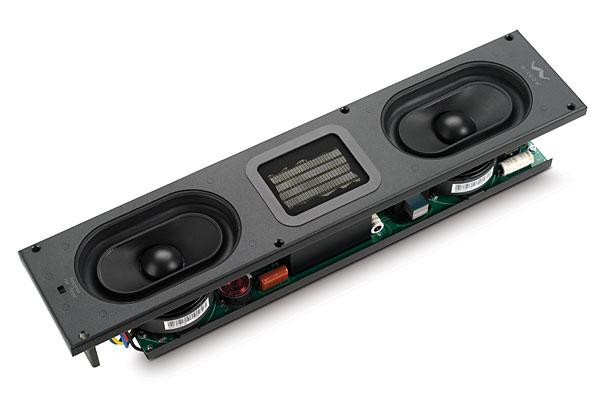
A New Insight
Wanting to spread the gospel of high-end sound to more people (and sell more speakers), the Wisdom folks decided to see if they could squeeze most of the sound quality of the Sage Series into a less imposing, less costly package. The new Insight Series speakers are the result, and Wisdom Audio shipped three P4i ($2,050/each) and two P2i ($1,550/each) speakers for me to install in the walls of my home theater room.* By the time you read this, an in-wall version of Wisdom Audio’s SCS subwoofer will be available; but it wasn’t ready for this review. Instead, I matched the system up with a $1,700 Sunfire HRS-IW8 in-wall subwoofer (and its associated 520-watt HRS-IW8 amplifier) that I had in for review to complete the architectural experience.
One huge cost-saving difference between the Insight and Sage series is that the new speakers use passive, internal crossovers. This not only lowers the price of the speakers, but since they no longer need to be biamped, it cuts the number of required amplifier channels in half and eliminates the need for the SC-1 Controller (although, Wisdom says, you can still use it with the Insight speakers for room acoustics correction). That being said, $9,250 for five in-wall speakers still isn’t the cheapest architectural speaker package around. At best, it moves from the budget-crushing to the budget-busting category for most people. So the important question is, does it give eight grand worth of performance?
 No Planar, No Gainer
No Planar, No Gainer
One of the things the Insight Series speakers inherited from the Sage Series is some geeky driver technology, including planar magnetic drivers (PMDs). Although PMDs utilize a vibrating thin film to produce sound, they’re different from the more commonly known electrostatic and folded-planar magnetic tweeter designs we’ve seen in some speakers lately. At the heart of all three designs is a thin, lightweight, film diaphragm material; but in the PMD, the wire that would normally make up the voice coil in a traditional cone driver is unwound and bonded to the PMD’s film across most of its surface. (Wisdom Audio’s Herron says it resembles a car’s rear-window defogger.) This film diaphragm/voice grid combo is then stretched between a series of bar magnets, and the current from your amplifier runs through this rear-window defogger and causes it to move forwards and backwards. Simple stuff, right?
Hardly. It’s a difficult design to do right, which is a big reason why you don’t see it used in many speakers from more familiar brands. On the other hand, Herron says, if it’s done properly, the benefits are that PMDs can be highly detailed with excellent transient response (the diaphragm is lighter than the air it acts on); quite reliable (the spread-out “voice grid” is great at dissipating heat); super-easy for an amplifier to drive (it’s “an almost perfectly resistive load”); and designed for use as either a monopole or dipole driver (the latter projects sound from both the front and back).
Brace Yourself
Both the Insight P4i and the P2i use the same 2 x 3-inch monopole PMDs. In the case of the 31.5-inch-tall P4i, the PMD sits sandwiched between two 3 x 5-inch “obround” bass drivers above and below it. The 19.5-inch-tall P2i is oriented the same way, except there’s only one bass driver above and below the PMD. Both the P4i and P2i are two-way speakers, and the crossover point in each is a surprisingly low 650 hertz—which means the PMD is responsible for everything above that frequency. The bass drivers use a traditional moving voice coil design featuring a wound, cylindrical voice coil and magnet structure, but to minimize the width of the speaker’s front baffle the shape of the driver is described as obround—something Merriam-Webster defines as “having the form of a flattened cylinder with the sides parallel and the ends hemispherical.” (I couldn’t have said it better myself, so I didn’t.)
I installed the left and right front P4is vertically and chose to do a real-world horizontal install of the P4i being used as a center channel under my Samsung plasma TV. Unlike some of the company’s more expensive speakers, such as the Insight L8i, which are line-source designs, the P4i and P2i speakers are point sources. As a result, Wisdom Audio assured me that the P4i would perform just as well horizontally as it does vertically. Of course, it’s not as easy as simply cutting a rectangle in the Sheetrock when you’re mounting a 31.5-inch-long speaker in a wall with studs on a standard 16-inch center layout. Quite frankly, it’s a pain in the ass to do because, in a retrofit situation like mine, I had to cut out a 4-something-inch-long chunk from two of the studs to be able to fit the P4i’s 3.5 inches of depth into the wall cavity. Then I had to brace the hell out of the cut studs, not only to keep the wall from vibrating, but because there’s a heavy, 58-inch plasma TV hanging on a bracket bolted into those studs. Of course, it’s a much simpler deal if you’re building or remodeling since you can have the stud layout and bracing done accordingly before the walls go up. If you are going to essentially build a stud enclosure for a horizontal P4i or P2i install, Wisdom Audio has specifications for minimum rear enclosure volumes of 0.66 cubic feet and 0.36 cubic feet, respectively. All of the Insight Series speakers are open-back, infinite baffle designs, so the volume of the wall cavity makes a difference.
- Log in or register to post comments

